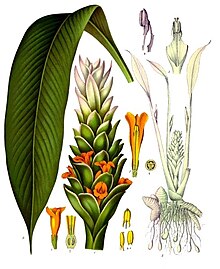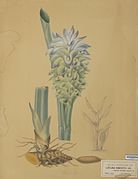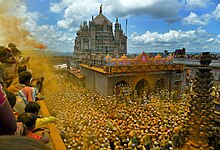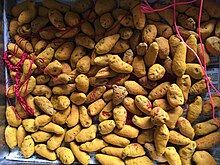| Turmeric | |
|---|---|

| |
| Inflorescence of Curcuma longa | |

| |
| Turmeric rhizome and powder | |
| Scientific classification | |
| Kingdom: | Plantae |
| Clade: | Tracheophytes |
| Clade: | Angiosperms |
| Clade: | Monocots |
| Clade: | Commelinids |
| Order: | Zingiberales |
| Family: | Zingiberaceae |
| Genus: | Curcuma |
| Species: | C. longa |
| Binomial name | |
| Curcuma longa L. | |
| Synonyms | |
|
Curcuma domestica Valeton | |
Turmeric (/ˈtɜːrmərɪk, ˈtjuː-/), (botanical name Curcuma longa (/ˈkɜːrkjʊmə ˈlɒŋɡə/),) is a flowering plant in the ginger family Zingiberaceae. It is a perennial, rhizomatous, herbaceous plant native to the Indian subcontinent and Southeast Asia that requires temperatures between 20 and 30 °C (68 and 86 °F) and high annual rainfall to thrive. Plants are gathered each year for their rhizomes, some for propagation in the following season and some for consumption.
The rhizomes are used fresh or boiled in water and dried, after which they are ground into a deep orange-yellow powder commonly used as a coloring and flavoring agent in many Asian cuisines, especially for curries, as well as for the dyeing characteristics imparted by the principal turmeric constituent, curcumin.
Turmeric powder has a warm, bitter, black pepper-like flavor and earthy, mustard-like aroma.
Curcumin, a bright yellow chemical produced by the turmeric plant, is approved as a food additive by the World Health Organization, European Parliament, and United States Food and Drug Administration.
Although long used in Ayurvedic medicine, there is no high-quality clinical evidence that consuming turmeric or curcumin is effective for treating any disease.

Origin and distribution
The greatest diversity of Curcuma species by number alone is in India, at around 40 to 45 species. Thailand has a comparable 30 to 40 species. Other countries in tropical Asia also have numerous wild species of Curcuma. Recent studies have also shown that the taxonomy of C. longa is problematic, with only the specimens from South India being identifiable as C. longa. The phylogeny, relationships, intraspecific and interspecific variation, and even identity of other species and cultivars in other parts of the world still need to be established and validated. Various species currently utilized and sold as "turmeric" in other parts of Asia have been shown to belong to several physically similar taxa, with overlapping local names.
History
Turmeric has been used in Asia for centuries and is a major part of Ayurveda, Siddha medicine, traditional Chinese medicine, Unani, and the animistic rituals of Austronesian peoples. It was first used as a dye, and then later for its supposed properties in folk medicine.
In India, it spread with Hinduism and Buddhism, as the yellow dye is used to color the robes of monks and priests.
In Island Southeast Asia, there is linguistic and circumstantial evidence of the ancient use of turmeric among the Austronesian peoples soon after dispersal from Taiwan (starting c. 3000 BCE), before contact with India. In Indonesia and the Philippines, turmeric was used for food, dyeing textiles, medicine, as well as body painting. It was commonly an important ingredient in various animistic rituals. Kikusawa and Reid (2007) have concluded that *kunij, the oldest reconstructed Proto-Malayo-Polynesian form for "turmeric" in the Austronesian languages, is primarily associated with the importance of its use as a dye. Other members of the genus Curcuma native to Southeast Asia (like Curcuma zedoaria) were also used for food and spice, but not as dyes.
Turmeric (along with Curcuma zedoaria) was also spread with the Lapita people of the Austronesian expansion into Oceania. Turmeric can only be propagated with rhizomes, thus its pre-contact distribution into the Pacific Islands can only be via human introduction. The populations in Micronesia, Island Melanesia, and Polynesia (including as far as Hawaii and Easter Island) use turmeric widely for both food and dye before European contact. In Micronesia, it was an important trade item in the sawei maritime exchange between Yap and further atolls in the Carolines, where it couldn't grow. In some smaller islands, the dye was extracted from the leaves, since the rhizomes remained too small in sandy soils. It was also carried by the Austronesian migrations to Madagascar.
Turmeric was found in Farmana, dating to between 2600 and 2200 BCE, and in a merchant's tomb in Megiddo, Israel, dating from the second millennium BCE. It was noted as a dye plant in the Assyrians' Cuneiform medical texts from Ashurbanipal’s library at Nineveh from 7th century BCE. In Medieval Europe, turmeric was called "Indian saffron."
Etymology
The name possibly derives from Middle English or Early Modern English as turmeryte or tarmaret. It may be of Latin origin, terra merita ("meritorious earth"). The Latin specific epithet longa means long.
Description
| This section needs additional citations for verification. Please help improve this article by adding citations to reliable sources in this section. Unsourced material may be challenged and removed. (June 2021) (Learn how and when to remove this message) |
Turmeric is a perennial herbaceous plant that reaches up to 1 m (3 ft 3 in) tall. It has highly branched, yellow to orange, cylindrical, aromatic rhizomes.
The leaves are alternate and arranged in two rows. They are divided into leaf sheath, petiole, and leaf blade. From the leaf sheaths, a false stem is formed. The petiole is 50 to 115 cm (20–45 in) long. The simple leaf blades are usually 76 to 115 cm (30–45 in) long and rarely up to 230 cm (7 ft 7 in). They have a width of 38 to 45 cm (15 to 17+1⁄2 in) and are oblong to elliptical, narrowing at the tip.
Inflorescence, flower, and fruit
At the top of the inflorescence, stem bracts are present on which no flowers occur; these are white to green and sometimes tinged reddish-purple, and the upper ends are tapered.
The hermaphrodite flowers are zygomorphic and threefold. The three sepals are 0.8 to 1.2 cm (3⁄8 to 1⁄2 in) long, fused, and white, and have fluffy hairs; the three calyx teeth are unequal. The three bright-yellow petals are fused into a corolla tube up to 3 cm (1+1⁄4 in) long. The three corolla lobes have a length of 1.0 to 1.5 cm (3⁄8–5⁄8 in) and are triangular with soft-spiny upper ends. While the average corolla lobe is larger than the two lateral, only the median stamen of the inner circle is fertile. The dust bag is spurred at its base. All other stamens are converted to staminodes. The outer staminodes are shorter than the labellum. The labellum is yellowish, with a yellow ribbon in its center and it is obovate, with a length from 1.2 to 2.0 cm (1⁄2 to 3⁄4 in). Three carpels are under a constant, trilobed ovary adherent, which is sparsely hairy. The fruit capsule opens with three compartments.
In East Asia, the flowering time is usually in August. Terminally on the false stem is an inflorescence stem, 12 to 20 cm (4+1⁄2 to 8 in) long, containing many flowers. The bracts are light green and ovate to oblong with a blunt upper end with a length of 3 to 5 cm (1 to 2 in).
-
 Curcuma domestica Valeton, a drawing by A. Bernecker around 1860
Curcuma domestica Valeton, a drawing by A. Bernecker around 1860
-
 Turmeric farm on Deccan Plateau
Turmeric farm on Deccan Plateau
-
 Turmeric flower
Turmeric flower
Phytochemistry


Turmeric powder is about 60–70% carbohydrates, 6–13% water, 6–8% protein, 5–10% fat, 3–7% dietary minerals, 3–7% essential oils, 2–7% dietary fiber, and 1–6% curcuminoids. The golden yellow color of turmeric is due to curcumin.
Phytochemical components of turmeric include diarylheptanoids, a class including numerous curcuminoids, such as curcumin, demethoxycurcumin, and bisdemethoxycurcumin. Curcumin constitutes up to 3.14% of assayed commercial samples of turmeric powder (the average was 1.51%); curry powder contains much less (an average of 0.29%). Some 34 essential oils are present in turmeric, among which turmerone, germacrone, atlantone, and zingiberene are major constituents.
Uses
Culinary
| This section needs additional citations for verification. Please help improve this article by adding citations to reliable sources in this section. Unsourced material may be challenged and removed. Find sources: "Turmeric" – news · newspapers · books · scholar · JSTOR (June 2017) (Learn how and when to remove this message) |
Turmeric is one of the key ingredients in many Asian dishes, imparting a mustard-like, earthy aroma and pungent, slightly bitter flavor to foods. It is used mostly in savory dishes, but also is used in some sweet dishes, such as the cake sfouf. In India, turmeric leaf is used to prepare special sweet dishes, patoleo, by layering rice flour and coconut-jaggery mixture on the leaf, then closing and steaming it in a special utensil (chondrõ). Most turmeric is used in the form of rhizome powder to impart a golden yellow color. It is used in many products such as canned beverages, baked products, dairy products, ice cream, yogurt, yellow cakes, orange juice, biscuits, popcorn, cereals and sauces. It is a principal ingredient in curry powders. Although typically used in its dried, powdered form, turmeric also is used fresh, like ginger.
Turmeric is used widely as a spice in South Asian and Middle Eastern cooking. Various Iranian khoresh recipes begin with onions caramelized in oil and turmeric. The Moroccan spice mix ras el hanout typically includes turmeric. In South Africa, turmeric is used to give boiled white rice a golden color, known as geelrys (yellow rice) traditionally served with bobotie. In Vietnamese cuisine, turmeric powder is used to color and enhance the flavors of certain dishes, such as bánh xèo, bánh khọt, and mì Quảng. The staple Cambodian curry paste, kroeung, used in many dishes, including fish amok, typically contains fresh turmeric. In Indonesia, turmeric leaves are used for Minang or Padang curry base of Sumatra, such as rendang, sate padang, and many other varieties. In the Philippines, turmeric is used in the preparation and cooking of kuning, satti, and some variants of adobo. In Thailand, fresh turmeric rhizomes are used widely in many dishes, in particular in the southern Thai cuisine, such as yellow curry and turmeric soup. Turmeric is used in a hot drink called "turmeric latte" or "golden milk" that is made with milk, frequently coconut milk. The turmeric milk drink known as haldī dūdh (haldī means turmeric in Hindi) is a traditional Indian recipe. Sold in the US and UK, the drink known as "golden milk" uses nondairy milk and sweetener, and sometimes black pepper after the traditional recipe (which may also use ghee).
Turmeric is approved for use as a food color, assigned the code E100. The oleoresin is used for oil-containing products.
In combination with annatto (E160b), turmeric has been used to color numerous food products. Turmeric is used to give a yellow color to some prepared mustards, canned chicken broths, and other foods—often as a much cheaper replacement for saffron.
-
 Cleaning turmeric rhizomes with boiling water
Cleaning turmeric rhizomes with boiling water
-
 Drying turmeric rhizomes
Drying turmeric rhizomes
-
 Turmeric powder
Turmeric powder
-
 Cooked vegetables with turmeric as one of its key ingredients, referred to as Sabzi, a dish from India
Cooked vegetables with turmeric as one of its key ingredients, referred to as Sabzi, a dish from India
-
 Ganghwang-bap (turmeric rice)
Ganghwang-bap (turmeric rice)
-
 Patoleo – sweet rice cakes steamed in turmeric leaves consisting of a filling of coconut and coconut palm sugar prepared in Goan Catholic style
Patoleo – sweet rice cakes steamed in turmeric leaves consisting of a filling of coconut and coconut palm sugar prepared in Goan Catholic style
Traditional uses

In 2019, the European Medicines Agency concluded that turmeric herbal teas, or other forms taken by mouth, on the basis of their long-standing traditional use, could be used to relieve mild digestive problems, such as feelings of fullness and flatulence.
Turmeric grows wild in the forests of South and Southeast Asia, where it is collected for use in classical Indian medicine (Siddha or Ayurveda). In Eastern India, the plant is used as one of the nine components of nabapatrika along with young plantain or banana plant, taro leaves, barley (jayanti), wood apple (bilva), pomegranate (darimba), Saraca indica, manaka (Arum), or manakochu, and rice paddy. The Haldi ceremony called gaye holud in Bengal (literally "yellow on the body") is a ceremony observed during wedding celebrations of people of Indian culture all throughout the Indian subcontinent.

In Tamil Nadu and Andhra Pradesh, as a part of the Tamil–Telugu marriage ritual, dried turmeric tuber tied with string is used to create a Thali necklace. In western and coastal India, during weddings of the Marathi and Konkani people, Kannada Brahmins, turmeric tubers are tied with strings by the couple to their wrists during a ceremony, Kankana Bandhana. In many Hindu communities, turmeric paste is applied to the bride and groom as part of pre-wedding festivities known as the haldi ceremony.
Turmeric makes a poor fabric dye, as it is not light fast, but is commonly used in Indian clothing, such as saris and Buddhist monks' robes. During the late Edo period (1603–1867), turmeric was used to dilute or substitute more expensive safflower dyestuff in the production of beni itajime shibori. Friedrich Ratzel reported in The History of Mankind during 1896, that in Micronesia, turmeric powder was applied for embellishment of body, clothing, utensils, and ceremonial uses. Native Hawaiians who introduced it to Hawaii (Hawaiian: ʻōlena) make a bright yellow dye out of it.
Indicator

Turmeric paper, also called curcuma paper or in German literature, Curcumapapier, is paper steeped in a tincture of turmeric and allowed to dry. It is used in chemical analysis as an indicator for acidity and alkalinity. The paper is yellow in acidic and neutral solutions and turns brown to reddish-brown in alkaline solutions, with transition between pH of 7.4 and 9.2.
Adulteration
As turmeric and other spices are commonly sold by weight, the potential exists for powders of toxic, cheaper agents with a similar color to be added, such as lead(II,IV) oxide ("red lead"). These additives give turmeric an orange-red color instead of its native gold-yellow, and such conditions led the US Food and Drug Administration (FDA) to issue import alerts from 2013 to 2019 on turmeric originating in India and Bangladesh. Imported into the United States in 2014 were approximately 5.4 million kilograms (12 million pounds) of turmeric, some of which was used for food coloring, traditional medicine, or dietary supplement. Lead detection in turmeric products led to recalls across the United States, Canada, Japan, Korea, and the United Kingdom through 2016.
Lead chromate, a bright yellow chemical compound, was found as an adulterant of turmeric in Bangladesh, where turmeric is used commonly in foods and the contamination levels were up to 500 times higher than the national limit. Researchers identified a chain of sources adulterating the turmeric with lead chromate: from farmers to merchants selling low-grade turmeric roots to "polishers" who added lead chromate for yellow color enhancement, to wholesalers for market distribution, all unaware of the potential consequences of lead toxicity.
Another common adulterant in turmeric, metanil yellow (also known as acid yellow 36), is considered by the British Food Standards Agency as an illegal dye for use in foods.
Medical research
See also: CurcuminTurmeric and curcumin have been studied in numerous clinical trials for various human diseases and conditions, with no high-quality evidence of any anti-disease effect or health benefit. There is no scientific evidence that curcumin reduces inflammation, as of 2020. There is weak evidence that turmeric extracts may be beneficial for relieving symptoms of knee osteoarthritis, as well as for reducing pain and muscle damage following physical exercise. There is good evidence that turmeric is an allergen.
See also
- Alpinia zerumbet
- Curcuma xanthorrhiza
- Curcuma zedoaria
- Domesticated plants and animals of Austronesia
- Etlingera elatior
- Kaempferia galanga
References
- ^ "Curcuma longa L." Plants of the World Online. Royal Botanic Gardens, Kew. Retrieved 26 March 2018.
- "turmeric". Dictionary.com Unabridged (Online). n.d.
- "turmeric". Merriam-Webster.com Dictionary. Merriam-Webster.
- "curcuma". Dictionary.com Unabridged (Online). n.d.
- "longa". Merriam-Webster.com Dictionary. Merriam-Webster.
- ^ Curcumin from PubChem
- ^ "Turmeric". Drugs.com. 2009. Retrieved 24 August 2017.
- ^ Brennan, J (15 October 2008). "Turmeric". The National.
- ^ Nelson, KM; Dahlin, JL; Bisson, J; et al. (2017). "The Essential Medicinal Chemistry of Curcumin: Miniperspective". Journal of Medicinal Chemistry. 60 (5): 1620–1637. doi:10.1021/acs.jmedchem.6b00975. PMC 5346970. PMID 28074653.
None of these studies yet led to the approval of curcumin, curcuminoids, or turmeric as a therapeutic for any disease
- ^ "Turmeric". National Center for Complementary and Integrative Health, US National Institutes of Health. May 2020. Retrieved 25 November 2020.
- Leong-Škornickova, Jana; Šida, Otakar; Wijesundara, Sirtl; Marhold, Karol (May 2008). "On the identity of turmeric: the typification of Curcuma longa L. (Zingiberaceae)". Botanical Journal of the Linnean Society. 157 (1): 37–46. doi:10.1111/j.1095-8339.2008.00788.x.
- Nair, K.P. Prabhakaran (2013). The Agronomy and Economy of Turmeric and Ginger: The Invaluable Medicinal Spice Crops. Newnes. pp. 7–10. ISBN 9780123948243.
- Chattopadhyay I, Kaushik B, Uday B, Ranajit KB (2004). "Turmeric and curcumin: Biological actions and medicinal applications" (PDF). Current Science. 87 (1): 44–53. ISSN 0011-3891. Retrieved 16 March 2013.
- ^ Kikusawa, Ritsuko; Reid, Lawrence A. (2007). "Proto who utilized turmeric, and how?" (PDF). In Siegel, Jeff; Lynch, John; Eades, Diana (eds.). Language Description, History and Development: Linguistic indulgence in memory of Terry Crowley. John Benjamins Publishing Company. pp. 339–352. ISBN 9789027292940. Archived from the original (PDF) on 25 November 2021. Retrieved 18 January 2019.
- ^ McClatchey, W. (1993). "Traditional use of Curcuma longa (Zingiberaceae) in Rotuma". Economic Botany. 47 (3): 291–296. doi:10.1007/bf02862297. S2CID 20513984.
- ^ Pickersgill, Barbara (2005). Prance, Ghillean; Nesbitt, Mark (eds.). The Cultural History of Plants. Routledge. p. 170. ISBN 0415927463.
- Scott, Ashley; Power, Robert C.; Altmann-Wendling, Victoria; et al. (17 December 2020). "Exotic foods reveal contact between South Asia and the Near East during the second millennium BCE". Proceedings of the National Academy of Sciences. 118 (2): e2014956117. Bibcode:2021PNAS..11814956S. doi:10.1073/pnas.2014956117. hdl:10550/76877. ISSN 0027-8424. PMC 7812755. PMID 33419922.
- "turmeric". Dictionary.com Unabridged (Online). n.d. Retrieved 11 October 2012.
- "Curcuma longa - Plant Finder". www.missouribotanicalgarden.org. Retrieved 11 July 2023.
- ^ "Curcuma longa". Flora of China. Retrieved 30 November 2013 – via eFloras.org, Missouri Botanical Garden, St. Louis, MO & Harvard University Herbaria, Cambridge, MA.
- Siewek, F (2013). Exotische Gewürze Herkunft Verwendung Inhaltsstoffe (in German). Springer-Verlag. p. 72. ISBN 978-3-0348-5239-5.
- Hänsel, Rudolf; Keller, Konstantin; Rimpler, Horst; Schneider, Gerhard, eds. (2013). Drogen A-D (in German). Springer-Verlag. p. 1085. ISBN 978-3-642-58087-1.
- Tayyem RF, Heath DD, Al-Delaimy WK, Rock CL (2006). "Curcumin content of turmeric and curry powders". Nutr Cancer. 55 (2): 126–131. doi:10.1207/s15327914nc5502_2. PMID 17044766. S2CID 12581076.
- Hong, SL; Lee, G. S; Syed Abdul Rahman, SN; et al. (2014). "Essential Oil Content of the Rhizome of Curcuma purpurascens Bl. (Temu Tis) and Its Antiproliferative Effect on Selected Human Carcinoma Cell Lines". The Scientific World Journal. 2014: 1–7. doi:10.1155/2014/397430. PMC 4142718. PMID 25177723.
- Hu, Y; Kong, W; Yang, X; et al. (2014). "GC-MS combined with chemometric techniques for the quality control and original discrimination of Curcumae longae rhizome: Analysis of essential oils". Journal of Separation Science. 37 (4): 404–11. doi:10.1002/jssc.201301102. PMID 24311554.
- Braga, ME; Leal, PF; Carvalho, JE; Meireles, MA (2003). "Comparison of yield, composition, and antioxidant activity of turmeric (Curcuma longa L.) extracts obtained using various techniques". Journal of Agricultural and Food Chemistry. 51 (22): 6604–11. doi:10.1021/jf0345550. PMID 14558784.
- Pereira Kamat, M (16 August 2008), "A tradition wrapped in leaves", The Times of India, Goa, India, archived from the original on 9 October 2018, retrieved 16 August 2017
- ^ "E100: Curcumin". UKfoodguide.net. Archived from the original on 7 July 2017. Retrieved 14 April 2017.
- ^ Imtiaz, Sabia (11 May 2016). "Turmeric latte: the 'golden milk' with a cult following". The Guardian. Retrieved 7 January 2018.
- NIIR Board of Consultants & Engineers (2006). The Complete Book on Spices & Condiments (with Cultivation, Processing & Uses). Delhi: Asia Pacific Business Press. pp. 188–191. ISBN 9788178330389.
- "Curcuma longa L., rhizoma". European Medicines Agency. 14 February 2019. Retrieved 19 November 2020.
- Khan, Maheen (11 November 2014). "A Bangladeshi Wedding Journal – Gaye Holud: Pre-Wedding Ceremony". The Daily Star. Retrieved 22 February 2017.
- Singh K, S; Bhanu, BV (2004). People of India: Maharashtra, Volume 1. Popular Prakashan. p. 487. ISBN 9788179911006.
- Ramadurai, Charukesi. "India's original "turmeric latte"". www.bbc.com. Retrieved 24 August 2023.
- Arai, Masanao; Iwamoto Wada, Yoshiko (2010). "BENI ITAJIME: CARVED BOARD CLAMP RESIST DYEING IN RED" (PDF). Textile Society of America Symposium Proceedings. Lincoln: University of Nebraska. Archived from the original on 2 November 2021.
- Ratzel, Friedrich (1896). The History of Mankind. London: MacMillan.
- Welch, Zoe (27 May 2020). "Making dye from native and canoe plants". Mānoa Heritage Centre. Retrieved 28 October 2022.
- Ravindran, P. N., ed. (2007). The genus Curcuma. Boca Raton, FL: Taylor & Francis. p. 244. ISBN 9781420006322.
- Berger, S; Sicker, D (2009). Classics in Spectroscopy. Wiley & Sons. p. 208. ISBN 978-3-527-32516-0.
- ^ Cowell W, Ireland T, Vorhees D, Heiger-Bernays W (2017). "Ground Turmeric as a Source of Lead Exposure in the United States". Public Health Reports. 132 (3): 289–293. doi:10.1177/0033354917700109. PMC 5415259. PMID 28358991.
- ^ Forsyth, Jenna E.; Nurunnahar, Syeda; Islam, Sheikh Shariful; et al. (2019). "Turmeric means "yellow" in Bengali: Lead chromate pigments added to turmeric threaten public health across Bangladesh". Environmental Research. 179 (Pt A): 108722. Bibcode:2019ER....179j8722F. doi:10.1016/j.envres.2019.108722. ISSN 0013-9351. PMID 31550596.
- "Producing and distributing food – guidance: Chemicals in food: safety controls; Sudan dyes and industrial dyes not permitted in food". Government of the United Kingdom. 8 October 2012. Retrieved 12 December 2015.
- Daily, JW; Yang, M; Park, S (2016). "Efficacy of Turmeric Extracts and Curcumin for Alleviating the Symptoms of Joint Arthritis: A Systematic Review and Meta-Analysis of Randomized Clinical Trials". Journal of Medicinal Food. 19 (8): 717–29. doi:10.1089/jmf.2016.3705. PMC 5003001. PMID 27533649.
- Vaughn, A. R.; Branum, A; Sivamani, RK (2016). "Effects of Turmeric (Curcuma longa) on Skin Health: A Systematic Review of the Clinical Evidence". Phytotherapy Research. 30 (8): 1243–64. doi:10.1002/ptr.5640. PMID 27213821. S2CID 46429012.
- White CM, Pasupuleti V, Roman YM, et al. (August 2019). "Oral turmeric/curcumin effects on inflammatory markers in chronic inflammatory diseases: A systematic review and meta-analysis of randomized controlled trials". Pharmacol Res (Meta-analysis). 146: 104280. doi:10.1016/j.phrs.2019.104280. PMID 31121255. S2CID 163166501.
- Wang Z, Singh A, Jones G, et al. (January 2021). "Efficacy and Safety of Turmeric Extracts for the Treatment of Knee Osteoarthritis: a Systematic Review and Meta-analysis of Randomised Controlled Trials" (PDF). Curr Rheumatol Rep. 23 (2): 11. doi:10.1007/s11926-020-00975-8. PMID 33511486. S2CID 231724282. Archived from the original (PDF) on 26 May 2023.
- Suhett, Lara Gomes; de Miranda Monteiro Santos, Rodrigo; Silveira, Brenda Kelly Souza; et al. (2021). "Effects of curcumin supplementation on sport and physical exercise: a systematic review". Critical Reviews in Food Science and Nutrition. 61 (6): 946–958. doi:10.1080/10408398.2020.1749025. ISSN 1549-7852. PMID 32282223. S2CID 215759520.
- Chaudhari SP, Tam AY, Barr JA (November 2015). "Curcumin: A Contact Allergen". J Clin Aesthet Dermatol. 8 (11): 43–8. PMC 4689497. PMID 26705440.
External links
 The dictionary definition of turmeric at Wiktionary
The dictionary definition of turmeric at Wiktionary
| Taxon identifiers | |
|---|---|
| Curcuma longa |
|